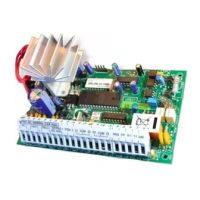P R O G R A M D E S C R I P T I O N S
22
[5] ...........Access Code Req. No code Req.
Attribute ON: the output requires a code for
activation.
Attribute OFF: no code required.
(only applicable to keypad-activated outputs)
PGM attributes return to their default settings when you change
PGM output options. Please see the programming worksheets
for a list of the default settings for each PGM output type.
Care should be taken in selecting the normal and active states
of each PGM output to ensure that an undesirable output state
does not occur after a loss and restore of AC power.
Attribute [3] must be ON (default) for PGM output
options [16].
If you program more than one PGM output as the
same output type (eg. if PGM1 and PGM2 are both
programmed as [19] Command Output 1), the
settings for output attributes [1], [2] and [5] must
be the same. This does not apply to outputs
programmed as types [09] and [10].
○○○○○○○○○○○○○○○○○○○○○○○○○○○○○○○○
○○○○○○○○○○○○○○○○○○○○○○○○○○○○○○○○
PGM Output Attributes ............................ Section [141]-[142]
5.12 Telephone Line Monitor (TLM)
When the TLM Enable option is selected, the panel will supervise
the telephone line and will indicate a trouble condition if the
telephone line is disconnected.
If the TLM Enable option is ON, the panel will check the
telephone line every 10 seconds. If the telephone line voltage
is below 3V for the number of checks programmed in the TLM
Trouble Delay section, the panel will report a TLM trouble. The
default number of checks is 3. Enter a number from [003] to
[255] in the TLM Trouble Delay section to change the number
of checks before the TLM trouble is reported. Programming a
delay means that a momentary interruption of the telephone line
will not cause a trouble condition.
If the TLM Trouble Beeps When Armed option is enabled, the
panel will indicate a TLM trouble at the keypad while the system
is armed. To activate the bell output in the case of a TLM trouble
while the system is armed, the TLM Audible (Bell) When
Armed option must be selected.
When the trouble condition is restored, the panel can send a
TLM Restoral reporting code. Any events which occur while
the telephone line is down will also be communicated.
If the LINKS1000 Cellular Communicator, or LINKS2X50 is
being used, the panel can be programmed to report a TLM
Trouble Reporting Code.
○○○○○○○○○○○○○○○○○○○○○○○○○○○○○○○○
TLM Enable/Disable ................................... Section [015]: [7]
TLM Trouble Beeps When Armed or
TLM Audible (Bell) When Armed ............... Section [015]: [8]
TLM Trouble Reporting Code............................ Section [349]
TLM Restoral Reporting Code .......................... Section [350]
○○○○○○○○○○○○○○○○○○○○○○○○○○○○○○○○
TLM Trouble Delay ............................................ Section [370]
5.13 Siren
The siren will silence after the number of minutes programmed
for the Bell Cut-off time have passed.
The panel supervises the Bell output. If an open condition is
detected, the panel will immediately indicate a trouble condition
by beeping the keypad twice every 10 seconds to alert the
owner of the problem. The panel can send a Bell Circuit
Trouble and Trouble Restoral reporting codes to indicate the
situation (see Section 5.8 “Communicator – Reporting Codes”).
If the Temporal Three Fire Signal option is enabled, all Fire
signals will follow the Temporal Three Pattern as described in
NFPA 72. If turned OFF all Fire signals will sound a one second
on, one second off cadence.
If Fire Bell Continuous is enabled, the alarm output will sound
until a code is entered. If disabled, the alarm will sound until a
code is entered or the bell cut-off time has expired.
○○○○○○○○○○○○○○○○○○○○○○○○○○○○○○○○
Bell Cut-off ......................................................... Section [005]
Bell Circuit Trouble Reporting Code ................. Section [349]
Bell Circuit Trouble Restoral Reporting Code .. Section [350]
Temporal Three Fire Signal Enable/Disable . Section [013]: [8]
○○○○○○○○○○○○○○○○○○○○○○○○○○○○○○○○
Fire Bell Continuous ................................... Section [014]: [8]
5.14 Test Transmission
To ensure that the communication link with the central station is
functioning properly, the panel can be programmed to send a
test transmission signal on a regular basis.
The panel can send a Periodic Test Transmission Reporting
Code at the programmed Test Transmission Time of Day. The
Test Transmission Cycle determines the period of time between
tests. The option Land Line Test Transmission in Minutes/
Days allows you to select whether the Land Line Test
Transmission cycle will be counted in minutes or days. If you
have selected the test transmission cycle to be in minutes, the
Test Transmission Time of Day counter will not apply.
If you have selected the Land Line Test Transmis-
sion in Minutes option, do not program the test
transmission cycle to be less than 10 minutes.
The LINKS Test Transmission can only be pro-
grammed in days.
If the test transmission cycle being programmed is of a lesser
value than the previous value, the system will wait the original
period before the next test transmission is sent, and then begin
reporting with the new interval.
The panel can also send a test for the LINKS1000 Cellular
Communicator, if being used. If the LINKS1000 Test
Transmission Code is programmed, the panel will send a
cellular test at the interval programmed in the LINKS Test
Transmission Cycle.
The end user can generate a communicator test. If the System
Test Reporting Code is programmed, the panel will send the
signal when the System Test keypad command is entered (see
Section 3.4 – “[✱] Commands; [✱] [6] User Functions”).
○○○○○○○○○○○○○○○○○○○○○○○○○○○○○○○○
Test Transmission Reporting Codes ................. Section [352]
Test Transmission Time of Day ......................... Section [371]
Test Transmission Cycles .................................. Section [370]
○○○○○○○○○○○○○○○○○○○○○○○○○○○○○○○○
Land Line Test Transmission M/D .............. Section [702]: [3]
5.15 Transmission Delay
If the transmission delay zone attribute is selected for a given
zone, the panel will delay reporting an alarm for that zone for the
number of seconds programmed for the Transmission Delay
Time. If the panel is disarmed before the delay time expires, the
panel will not report the event.

